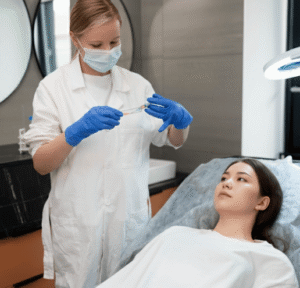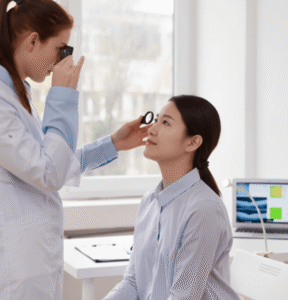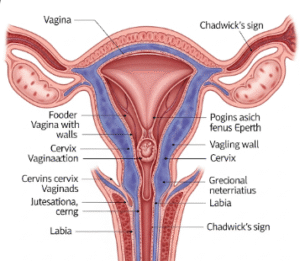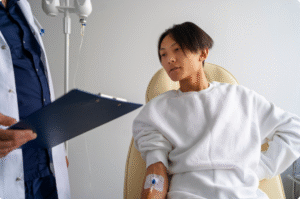What it is
Hypertrophic ear scar care in Korea refers to the treatment of raised, thickened scars that form on the ear following piercings, trauma, or surgery.
Unlike keloids, which grow beyond the wound boundary, hypertrophic scars stay within the original injury site but appear red, firm, and elevated. They may cause discomfort, itching, or cosmetic concerns.
→ In Korea, hypertrophic scar care combines dermatological treatments, scar-minimizing technology, and advanced skincare, focusing on flattening scars, reducing redness, and preventing progression into keloids.
• Commonly treated areas include earlobes and cartilage piercings.
• Treatment emphasizes aesthetic refinement as well as scar control.
Why it’s done
Patients in Korea seek hypertrophic ear scar care for several reasons:
→ Aesthetic concerns → Raised scars on the ear are noticeable and may affect symmetry.
→ Discomfort → Scars can feel itchy, tender, or tight.
→ Prevention of keloids → Early care prevents scars from developing into larger keloids.
→ Re-piercing readiness → Many patients want smoother lobes before considering new piercings.
→ Confidence → Flattening scars improves appearance and self-esteem.
Alternatives
Some alternative or supportive approaches include:
• Silicone gels or sheets → Applied daily to soften and flatten scars.
• Massage therapy → Helps remodel scar tissue, though results are limited.
• Over-the-counter scar creams → Contain onion extract or vitamin E; mild improvements only.
• Pressure earrings → Constant pressure can flatten early hypertrophic scars.
→ While these help mild cases, professional dermatology treatments in Korea are more effective for long-term results.
Preparation
Before starting scar treatment in Korea, preparation steps include:
- Dermatologist consultation → To confirm the scar is hypertrophic, not a keloid.
- Medical history → Check for keloid tendency, healing issues, or allergies.
- Skincare adjustments → Avoid irritants (retinoids, acids) on the area before treatment.
- Sun protection → Essential, as UV exposure can darken scars.
→ Patients are educated on realistic expectations—scars can improve significantly but may not disappear completely.
How it’s done
Hypertrophic ear scar care in Korea involves several options, often combined:
- Steroid injections (Triamcinolone)
- Flatten scars by reducing collagen overproduction.
- Administered every 4–6 weeks.
- Laser therapy
- Pulsed dye laser (PDL, V-beam) → Reduces redness and vascularity.
- Fractional CO₂ laser → Improves texture and smoothness.
- Silicone-based aftercare
- Gels or sheets prescribed for daily use to maintain scar flattening.
- Pressure earrings
- Special clip-on devices used after treatment to prevent recurrence.
- Surgical revision
- For large scars, excision followed by preventive injections or pressure therapy.
→ Treatments are usually repeated over several months for best results.
Recovery
Recovery after hypertrophic ear scar treatments is generally straightforward:
• Injections → Mild soreness for 1–2 days.
• Laser sessions → Redness and sensitivity for 1–3 days.
• Surgical revision → Stitches removed after 1–2 weeks, with scar care continuing for months.
• Daily care → Regular use of silicone gels and sun protection is critical.
→ With consistent care, scars become flatter, lighter, and less noticeable within 2–6 months.
Complication
While safe, possible risks include:
- Recurrence → Scars may thicken again without maintenance.
- Pigmentation changes → Treated area may darken or lighten temporarily.
- Infection → Rare, usually linked to improper wound care.
- Pain or tenderness → From repeated injections.
→ Korean specialists minimize these risks with combination therapy and close follow-up care.
Treatment option in Korea
Korea is a global leader in scar care and aesthetic dermatology, offering advanced solutions for hypertrophic ear scars:
→ Dermatology expertise → Clinics in Seoul and Busan specialize in scar management with customized protocols.
→ Cutting-edge lasers → V-beam, fractional CO₂, and Pico lasers are widely used.
• Combination approach → Steroid injections, lasers, and pressure therapy are often integrated for best results.
• Post-care support → Clinics provide scar gels, pressure earrings, and LED healing therapy as part of aftercare.
• Medical tourism → International patients frequently seek hypertrophic scar treatment in Korea due to its precision and cosmetic refinement.
→ With advanced technology and holistic protocols, hypertrophic ear scar care in Korea achieves natural-looking results while minimizing recurrence risk.













